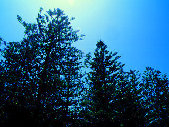
Deep in the mountainous interior of the mainland of Papua New Guinea, two of Paul's associates (native pastor Jacob Kepas and missionary Jim Blume) learned about a large glowing nocturnal creature that seemed like the ropen of Umboi Island. In Tawa Village, it's called "indava."
In mid-2006, after the publication of the first edition of Whitcomb's book "Searching for Ropens," Paul longed to go on another search in Papua New Guinea; but funding was hard to come by. One of the first readers of the book, a businessman in Florida, learned about the possibility of another search for ropens and helped sponsor Paul's late-2006 expeditioin to Tawa Village.
On several nights, Paul had several sightings: some genuine indava lights and a some misidentifications. But he finally videotaped the real thing when two lights on the top of a nearby ridge remained glowing a little longer than the five-to-six-second glow of the Umboi Island ropen.
Back in the U.S., a missile defense physicist, Cliff Paiva, analyzed the video footage and found no commonplace explanation for the lights. This vindicated Paul's work.
Expedition
(glowing owls)